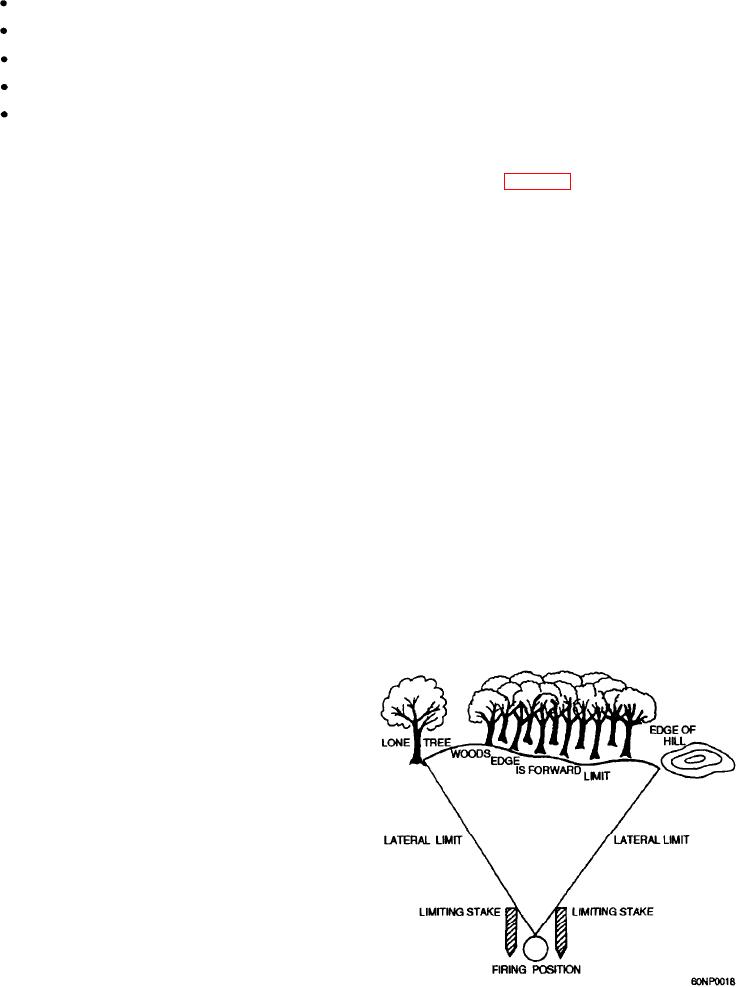
the enemy, firing positions should be selected that allow
Tactical employment of the companies
the fire of all or most of the weapons can be brought to
Preparation of obstacles
bear on the enemy simultaneously.
Coordination of fire from each company
The following paragraphs will discuss what forms
Coordination of supporting fire
a basic defensive firing position.
Priority for performance of tasks
SECTOR OF FIRE
The effectiveness of the defense depends not only
on the time available for its planning and preparation
but also on its advantageous use during the preparation
A sector of fire (fig. 4-3) is an area of responsi-
phase. This fundamental also applies after the
bility assigned to a squad, a platoon, or a crew-sewed
preparation phase because improvement continues
weapon to be covered by fire. The squad sector of fire
during the defense.
is divided into fire teams and individual sectors of fire
to cover the entire squad sector by fire. Sectors of fire
POSITIONING THE SQUAD IN THE
ensure mutual support by overlapping the individual
DEFENSE
and fire team sectors. Normally, the squad leader is
not assigned an individual sector of fire since the
The effectiveness of a unit in combat is largely
primary duty in the defense is directing and
dependent on selecting firing positions that allow the
controlling the squad. Located within each sector of
weapons of the unit to be used effectively and to keep
fire are lateral and forward limits.
the enemy from using their weapons. A primary duty
as a platoon commander or squad leader for a rifle
1. Lateral Limits: Readily identifiable terrain
platoon is positioning the squads in the defense.
features are selected to show the line of sight along each
When you are employing a squad in the defense, it is
side of the sector. Two stakes are firmly placed near the
good to review your previous experiences as a squad
position of a weapon to show the lateral limits for
member. Reflect upon the reasons you were
periods of reduced visibility.
positioned as a rifleman, grenadier, or other member
2. Forward Limits: The forward limit is
of a squad to better determine what type of defensive
established at the range at which the weapon will open
firing position is needed. There are many points to
fire. When possible, a terrain feature is selected to
consider in selecting a firing position. Some of these
locate the forward limit. This allows the squad leader
are as follows:
a method of control to open fire on the enemy at a
1. Mission: If the mission of the unit is to defend
precise time to maximize effectiveness.
an airfield, the firing positions of the unit must facilitate
the accomplishment of the mission, despite how good
other firing positions may be.
2. Enemy: The capabilities of an enemy usually
determine how he will attack. Mechanized units
usually attack through fields and other open terrain
where they can use the speed of their vehicles to an
advantage. Infantry units, however, seek to use the
cover and concealment provided by woods and other
close terrain. Firing positions that are ideal for
defending against mechanized units maybe useless for
defending against infantry units.
3. Observation and Fields of Fire: Seek to fire
on the enemy when he cannot fire on you and do not let
the enemy fire on you when you cannot fire on him.
4. Plan of Defense/Scheme of Maneuver: How
the battalion commander plans to use the companies
will influence the selection of firing positions. For
Figure 4-3.--Sector of fire.
example, if the battalion commander plans to surprise

